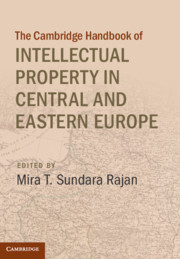Book contents
- The Cambridge Handbook of Intellectual Property in Central and Eastern Europe
- The Cambridge Handbook of Intellectual Property in Central and Eastern Europe
- Copyright page
- Dedication
- Epigraph
- Contents
- Figures
- Tables
- Contributors
- Foreword
- Acknowledgements
- 1 General Introduction – Intellectual Property in Central and Eastern Europe:
- 2 The Patent System in Pre-1989 Czechoslovakia
- 3 The Development of Hungarian Copyright Law until the Creation of the First Copyright Act (1793–1884)
- 4 Moral Rights and the Cultural Aspects of Hungarian Copyright Law:
- 5 The Polish Struggle with the Concept of Copyrightable Work:
- 6 Comparing Concepts of Originality in EU, Lithuanian, and US Law:
- 7 The Comparative Lessons of Itar-Tass Russian News Agency v. Russian Kurier
- 8 Communication to the Public under Union Law from the Perspective of Austrian and German Copyright Law: A Notion in Transition
- 9 Collective Management of Copyright in Hungary1
- 10 Exceptions and Limitations:
- 11 The Digitization of Czech Cultural Heritage and New Forms of Information Exclusivity
- 12 The Treatment of Authors’ Moral Rights in Georgia
- 13 Performers’ Rights: A Central European Export
- 14 The White Elephant in the Room:
- 15 A Central and Eastern European Perspective on EU Copyright Reform:
- 16 The Painter, the One Horn Cow, and Ole Hank Wilson’s Back Lot:
- 17 Does Paying Innovative Employees Pay Off?:
- 18 Intellectual Property Rights in Albania:
- 19 The Protection of Geographical Indications for Agricultural Products in the European Union
- 20 Legal Protection of the Traditional Knowledge and Traditional Cultural Expressions of the Indigenous Peoples of the Former Soviet Union*
- Index
1 - General Introduction – Intellectual Property in Central and Eastern Europe:
A New Era of Post-Socialist Transition
Published online by Cambridge University Press: 11 June 2019
- The Cambridge Handbook of Intellectual Property in Central and Eastern Europe
- The Cambridge Handbook of Intellectual Property in Central and Eastern Europe
- Copyright page
- Dedication
- Epigraph
- Contents
- Figures
- Tables
- Contributors
- Foreword
- Acknowledgements
- 1 General Introduction – Intellectual Property in Central and Eastern Europe:
- 2 The Patent System in Pre-1989 Czechoslovakia
- 3 The Development of Hungarian Copyright Law until the Creation of the First Copyright Act (1793–1884)
- 4 Moral Rights and the Cultural Aspects of Hungarian Copyright Law:
- 5 The Polish Struggle with the Concept of Copyrightable Work:
- 6 Comparing Concepts of Originality in EU, Lithuanian, and US Law:
- 7 The Comparative Lessons of Itar-Tass Russian News Agency v. Russian Kurier
- 8 Communication to the Public under Union Law from the Perspective of Austrian and German Copyright Law: A Notion in Transition
- 9 Collective Management of Copyright in Hungary1
- 10 Exceptions and Limitations:
- 11 The Digitization of Czech Cultural Heritage and New Forms of Information Exclusivity
- 12 The Treatment of Authors’ Moral Rights in Georgia
- 13 Performers’ Rights: A Central European Export
- 14 The White Elephant in the Room:
- 15 A Central and Eastern European Perspective on EU Copyright Reform:
- 16 The Painter, the One Horn Cow, and Ole Hank Wilson’s Back Lot:
- 17 Does Paying Innovative Employees Pay Off?:
- 18 Intellectual Property Rights in Albania:
- 19 The Protection of Geographical Indications for Agricultural Products in the European Union
- 20 Legal Protection of the Traditional Knowledge and Traditional Cultural Expressions of the Indigenous Peoples of the Former Soviet Union*
- Index
Summary
In the law, as in other domains, the predominance of English is both a gift and a curse. Ours is an age of global rapprochement, at least in the literal sense, brought about by technology. As national borders become increasingly porous, the possibility of conversations across legal cultures has never been more interesting or relevant. In no area of the law could this be more apparent than in relation to intellectual property, which is intimately connected with technological developments. English, as a shared language, makes these conversations possible – however halting or incomplete they might be – promising to enrich the understanding of law on all sides.
Keywords
- Type
- Chapter
- Information
- Publisher: Cambridge University PressPrint publication year: 2019

